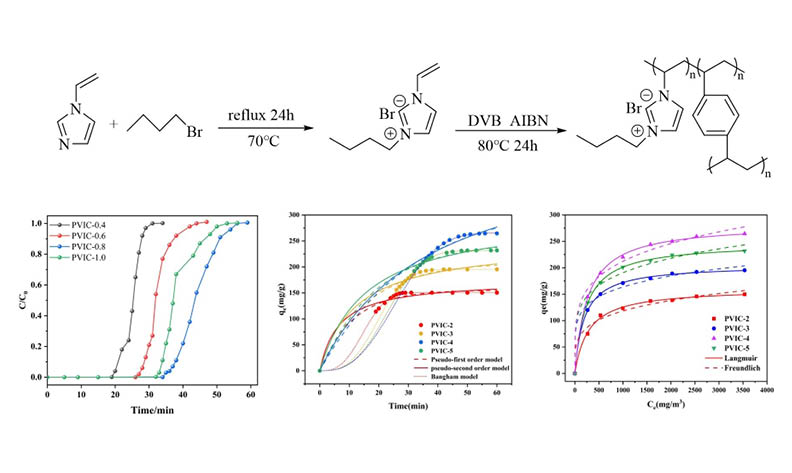Preparation of porous imidazole-based poly(ionic liquid) adsorbents and their toluene adsorption performance
DOI:
https://doi.org/10.17344/acsi.2024.8622Abstract
Efficient, economical, and durable adsorbents are required to remove volatile organic compounds (VOCs) from air. Cross-linked polyvinylic ionic liquids (PVIC) with porous structures were synthesized by quaternizing 1-vinylimidazole (1VI) with 1-bromobutane to obtain 3-butyl-1-vinylimidazolium bromide (VIC), which was then co-polymerized with divinylbenzene (DVB) radicals. 1H NMR, 13C NMR, scanning electron microscopy, X-ray photoelectron spectroscopy, Fourier-transform infrared spectroscopy, and N2 adsorption–desorption isotherms were applied in characterizing the composites. Through modification of the polymer structure by adjustment of DVB concentration(the ratio of DVB concentration to VIC concentration was x: 1 (x=0.4, 0.6, 0.8, 1.0) and the product was named PVIC-s (s=2, 3, 4, 5)), the optimal PVIC-4 pore structure was obtained, with a specific surface area and total pore volume of 192.5 m2 g–1 and 0.192 cm3 g–1, respectively. A toluene adsorption test verified the adsorption capacity. The adsorption behavior for VOCs, based on toluene, was investigated using adsorption breakthrough curves, adsorption kinetics, and isotherms. The adsorption process is well describing by the Bangham kinetic and Langmuir isotherm models. The dynamic adsorption of toluene followed the order PVIC-4 > PVIC-5 > PVIC-3 > PVIC-2. The optimum toluene adsorption by PVIC-4 was 264.4 mg g–1 as a result of its excellent pore structure. PVIC-4 also performed well in terms of recovery and has potential for the removal of VOCs from air

Downloads
Published
Issue
Section
License
Copyright (c) 2024 Fangwen Luo; Xujiao Tian; Xian Dong, Longchao liang, Zhuo Chen

This work is licensed under a Creative Commons Attribution 4.0 International License.
Except where otherwise noted, articles in this journal are published under the Creative Commons Attribution 4.0 International License
